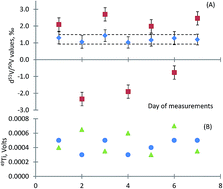Vanadium isotope ratio measurements in fruit-bodies of Amanita muscaria
Abstract
A new method has been developed for precise vanadium isotope ratio measurements by multi-collector inductively coupled plasma mass spectrometry (MC-ICPMS) in Amanita muscaria – a widespread toxic and hallucinogenic mushroom which is also known for its ability to bio-accumulate vanadium. Prior to isotope ratio measurements vanadium was separated from the sample matrix by anion-exchange chromatography with a single run of a sample solution through the anion-exchange column sufficient for the purification of vanadium. 51V/50V isotope ratio measurements were carried out in the high resolution mode of MC-ICPMS which allowed the separation of 50V+ and 51V+ ions from polyatomic interfering species, including sulphur-based ions. Iron was employed as an admixed internal standard and was found effective in correcting for the drift of instrumental mass bias. An important feature of the method was the use of a regression model in data reduction. The Plackett–Burman factorial design was used for ruggedness testing and showed that normalisation to the 56Fe/54Fe isotope ratio of the internal standard significantly improved the repeatability of the results. The combined standard uncertainties of δ51V values determined for samples of the mushroom ranged from 0.28‰ to 0.42‰. δ51V values for the samples collected in geographically different locations varied from −0.7‰ to 1.7‰, suggesting 51V/50V isotope ratio measurements as a useful tool for identifying the origin of Amanita muscaria in tasks concerned with counteracting the abuse of hallucinogenic mushrooms and in studies on the biochemistry of vanadium.


 Please wait while we load your content...
Please wait while we load your content...